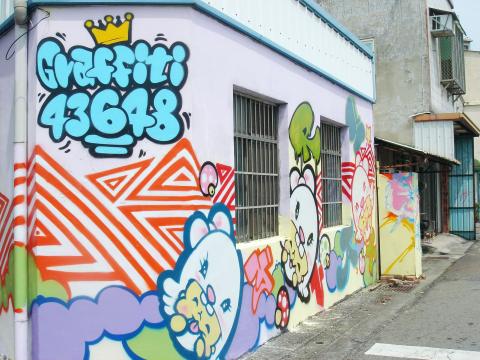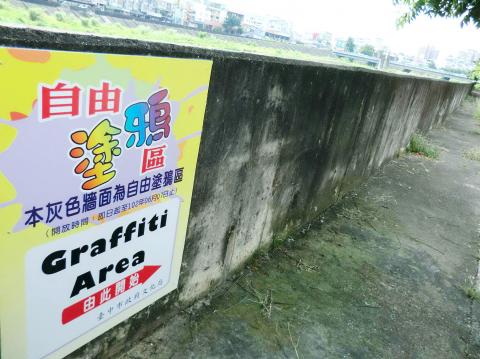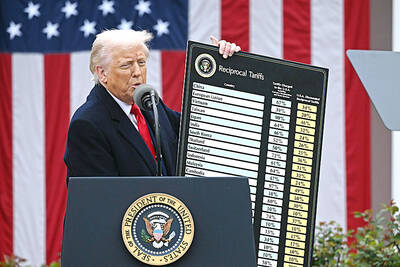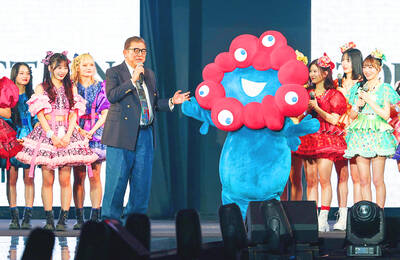Aside from the current designated graffiti areas located near Taichung Station, the Taichung City Government’s Cultural Affairs Bureau has added two more graffiti areas so that graffiti enthusiasts have more space to spray to their heart’s content. The newly added areas will be available until June of next year. The bureau urges people to make good use of the legal graffiti areas to make the city more attractive.
The graffiti areas currently available to the public are concentrated around the train station in the southern part of the city, including the wall on the east side along section four of Fuhsing Road, the southern and northern walls along Le Yeh Road, as well as the cement wall along Chunglun Street at section one of Jianguo Road. The four legal graffiti zones will remain available to the public until the end of the year.
The bureau says that in order to provide people who enjoy spraying graffiti with more space, they decided to increase the number of graffiti areas to include the cement walls along Chiti Road in Dali District (across from Li Shin Junior High School) and Hanhsi East Road in Taiping District, as well as the flood wall along Chingwu Road.

Photo: Ou Su-mei, Liberty Times
照片:自由時報記者歐素美
Bureau director Susan Yeh says that the city government first designed legal zones for graffiti in 2009 as an outlet for graffiti enthusiasts to express themselves freely. She says that the bureau hopes graffiti as an art form can become part of the city’s public art.
The bureau says that since the designated graffiti areas opened, they have attracted many graffiti artists and the overall reaction has been quite good. The bureau says it will make unscheduled inspections of the areas, and if they find any inappropriate drawings they will paint over them to avoid people getting the wrong impression about the graffiti areas or allowing the areas to lose their original positive significance.
(Liberty Times, Translated by Kyle Jeffcoat)

Photo courtesy of the Taichung City Government’s Cultural Affairs Bureau
照片由台中市文化局提供
為讓喜愛塗鴉的民眾有更多揮灑創意的空間,文化局在現有集中於台中火車站附近的合法塗鴉區之外,再增二處街頭塗鴉區,開放期限到明年六月,也呼籲民眾善加利用公告合法的自由塗鴉區,讓城市變得更美麗。
文化局目前已開放的塗鴉區多集中在南區火車站附近,包括復興路四段東側圍籬、樂業路南側與北側圍籬及建國北路一段近崇倫街的水泥圍牆等,共有四處合法塗鴉區,預計開放到今年底。
文化局指出,為讓喜愛塗鴉的民眾有更多發揮空間,新增的塗鴉區擴及大里區甲堤路水泥圍籬(近立新國中對面)及太平區旱溪東路一段與精武路交接處防洪牆,作為塗鴉示範區。
文化局長葉樹姍指出,市政府從二00九年起設計合法開放的空間,讓塗鴉客盡情展現、揮灑創意,就是希望讓塗鴉文化能以藝術化的方式呈現,更能成為城市公共藝術的一部分。
文化局指出,事實上,塗鴉示範區開放以後,確實吸引不少塗鴉客前往創作,普遍反應良好,該局也會不定期巡視,若發現有不雅文圖,均會塗刷掉,以免造成外界對塗鴉區的誤解,也喪失塗鴉區設立的美意,新增兩處塗鴉區開放期限到明年六月七日止。
(自由時報記者蘇孟娟)

US President Donald Trump is taking a blowtorch to the rules that have governed world trade for decades. The “reciprocal’’ tariffs that he announced Wednesday last week are likely to create chaos for global businesses and conflict with America’s allies and adversaries alike. Since the 1960s, tariffs — or import taxes — have emerged from negotiations between dozens of countries. Trump wants to seize the process. “Obviously, it disrupts the way that things have been done for a very long time,’’ said Richard Mojica, a trade attorney at Miller & Chevalier. “Trump is throwing that out the window ... Clearly this is

The Matsu pilgrimage is one of Taiwan’s most iconic annual religious events. This grand occasion is more than just a religious ceremony; it deeply reflects Taiwan’s history and culture. Originally, Matsu was the goddess of the sea, primarily responsible for protecting fishermen and ensuring their safe voyage. As immigrants brought Matsu worship to Taiwan, she gradually evolved into a deity overseeing health, business, and various aspects of life. In times of uncertainty, Matsu has become a vital source of spiritual comfort for the Taiwanese. The pilgrimage represents Matsu’s annual tour to inspect her domain, driving away evil and bringing

A: The World Expo 2025 is set to open in Osaka, Japan, on Sunday, with 158 countries and regions and nine international organizations participating in the event. B: Wow, what’s the theme this time? A: The theme is “Designing Future Society for Our Lives.” B: Do you want to go? How long will it last? A: It’ll run for 184 days, until Oct. 13. Maybe we can go to Osaka during summer vacation. A: 2025年世界博覽會預計週日將在日本大阪開幕,158個國家或地區及9大國際組織將參與盛會! B: 哇這次的主題是什麼? A: 主題是:「創造閃耀生命光輝的未來社會」。 B: 你想要去嗎?展出多久啊? A: 世博會共展出184天到10月13日,或許我們暑假時可以去大阪玩。 (By Eddy Chang, Taipei Times/台北時報張迪)

Dos & Don’ts — 想想看,這句話英語該怎麼說? 1. 我臥病三天。 ✔ I stayed in bed for three days. ✔ I kept to my bed for three days. χ I slept in my bed for three days. 註︰動詞 sleep 通常作「睡眠」解。例如:Usually we sleep eight hours a day. 「因病臥床」應用 to stay in bed 或 to keep to one’s bed. 2. 彼得容易傷風。 ✔ Peter is liable to colds (或to catch cold). ✔ Peter is subject to colds. χ Peter is easy to catch cold. 註︰easy 常用於事,可以說 English is easy to learn. 或 It is easy to learn English.,但不可以說 I am easy to learn English.。因為 easy 很少用於人,尤其用來指「容易」的場合。除非用在 an easy person 中,easy 在此意思是「隨和」。 另外,可以說 “It is easy to misuse the article.”